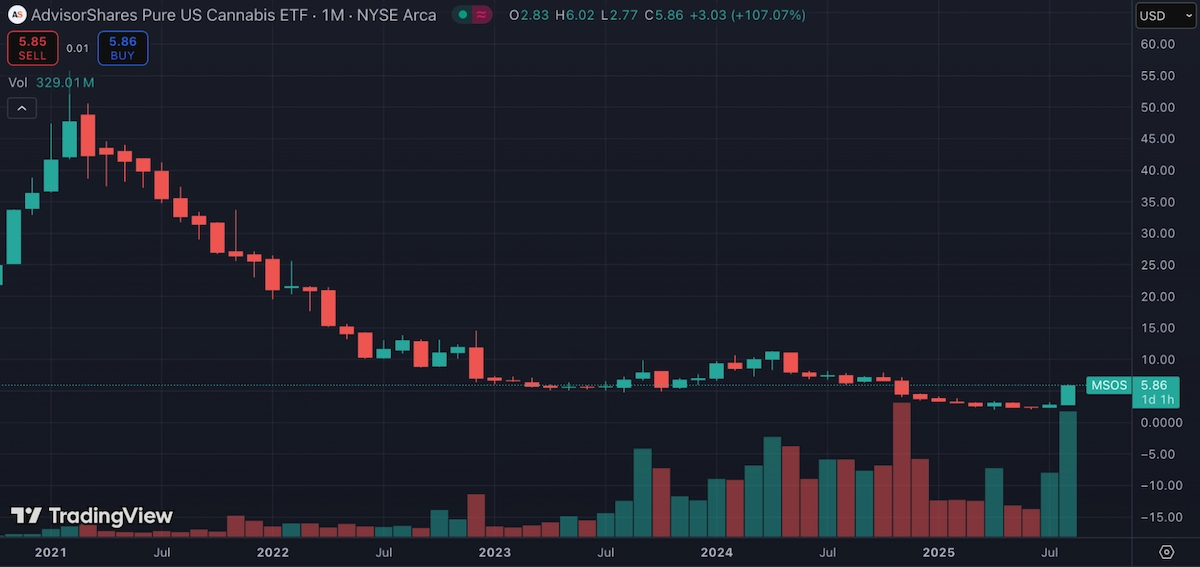After a 90% Crash, Weed Stocks Finally Bounced. Is It Real This Time?

Try not to puke.
That’s pretty much the best advice for anyone pulling up a 5-year chart of the U.S. cannabis sector. Just look at this monthly chart for the MSOS ETF. From the peak in early 2021 to the depths of this summer, it’s been a straight-line collapse. We’re talking 90% plus drawdowns across nearly every large-cap name. Curaleaf, Tilray, Trulieve, Verano, GTI. You name it. The charts all look like a ski slope straight into the abyss.

And it wasn’t just price. Sentiment was wrecked.
Nobody cared. Nobody was buying.
Companies were bleeding cash, shutting stores, missing estimates, and praying for mercy.
Investors moved on. Analysts ghosted the sector.
Then boom.
$MSOS doubles in a few weeks. Tilray rips. Most big names pop 40 to 100 percent.
What changed?
A guy in a red hat said he’s thinking about finally changing the rules.
That’s it.
Trump floated the idea of rescheduling marijuana, and the market finally caught a breath of life. Just a few words from him lit the match. After years of decline, that was enough to bring buyers back in.
But this bounce didn’t come out of nowhere.
This article is going to break down exactly where the cannabis market stands right now. We’ll look at how things got so bad, what’s actually changed, what companies are doing to survive, and whether this move has real legs or if it’s just another fakeout in the long, brutal decline of U.S. weed stocks.
Why it all fell apart
Before we get ahead of ourselves, it’s worth remembering why this market got obliterated in the first place.
At a high level, it comes down to this:
Too much hype. Not enough demand. Way too much supply.
From 2020 to early 2022, cannabis companies were in expansion mode.
Everyone was racing to open new stores, build new grows, enter new states, and chase every shiny press release. But the actual customer base wasn’t growing fast enough to justify it. Legal markets were already showing early signs of saturation, and yet operators kept building like demand would 5x overnight.
It didn’t.
And then everything that could go wrong… did.
No new major states legalized. Florida never flipped. Pennsylvania dragged its feet. And Congress completely fumbled federal reform.
Existing states flatlined. Sales in Arizona, Michigan, and even California started trending down. Too much product, not enough buyers.
The illicit market never went away. In some places, the illegal stuff was cheaper, stronger, and more convenient than legal weed.
Pricing collapsed. Everyone was racing to the bottom. Wholesale prices tanked. Retail margins disappeared.
280E taxes made it worse. Companies couldn’t even write off basic business expenses. They were paying tax like they were profitable… when they weren’t.
Capital dried up. No one wanted to fund cash-burning weed companies anymore. Equity was dead, and debt got expensive.
So while headlines kept promising growth and “inevitable” legalization, the reality was ugly.
Companies were bleeding cash. Investors were trapped. Valuations fell off a cliff.
By 2025, barely anyone was even watching anymore.
It was just a graveyard of bagholders.
What actually changed
Okay, so the setup was ugly. The sector was on life support.
But out of nowhere, August brought something it hadn’t seen in a long time:
Hope.
It started with Trump.
At a press event in early August, he was asked about marijuana laws. Instead of giving a canned answer or dodging the question, he said his administration would be “looking into rescheduling cannabis very soon.”
It wasn’t a policy rollout. It wasn’t even a full sentence.
But that was all it took.
The market ran with it.
Because for the first time in years, there was a real chance that federal reform wasn’t just a someday thing. It might actually be coming. And it might be coming under Trump of all people.
Then a few days later, the story got louder.
Congressional staffers started leaking that rescheduling to Schedule III is now seen as a near certainty in D.C. by the end of 2025.
People on the Hill were talking about it like it was already done.
And on top of that:
A new provision to let VA doctors recommend cannabis to veterans just passed both chambers
The SAFER Banking Act (the updated version of SAFE Banking) is getting ready to move again
A Republican bill to regulate hemp-derived THC products is gaining traction
Democrats are still pushing resolutions for full legalization and mass expungement
So for the first time in years, we’re seeing actual movement at the federal level.
Not just tweets. Not just campaign promises. Real bills. Real votes. Real momentum.
And whether you love or hate him, Trump jumpstarted all of it.
Side note: If you're not already reading The Marijuana Herald, you should be. Best source on the internet for cannabis policy updates, market shifts, and regulatory news.
Why rescheduling actually matters
So what’s the big deal about moving weed from Schedule I to Schedule III?
Here’s the simple version.
Right now, cannabis is still classified the same way as heroin.
That means it's considered to have “no accepted medical use” and a high potential for abuse, which also triggers a tax rule called 280E.
That’s the killer.
Because of 280E, cannabis businesses can’t write off basic expenses like rent, payroll, or marketing.
They get taxed on gross income instead of profit.
It’s like running a business with handcuffs on.
Rescheduling to Schedule III would change that.
Companies would finally be able to deduct normal business expenses
That alone could boost profit margins across the board
It would open the door to institutional investors, who can’t touch Schedule I companies
It could allow uplisting to the NYSE or Nasdaq, which would bring real liquidity
It would also clear the way for more medical research and FDA-regulated products
To be clear, this wouldn’t legalize weed.
Schedule III is still federally controlled.
But it would take the boot off the industry's neck. And in this market, that’s more than enough to move billions.
How companies are playing it now
While the headlines are finally exciting again, most cannabis companies have been operating like it’s still 2023.
No one is scaling. No one is making aggressive bets.
The game plan right now is simple:
Preserve cash.
Show positive EBITDA.
Pray the orange man delivers.
Over the past year, just about every major MSO has gone into cost-cutting mode.
Stores have been shut down. Headcount has been reduced. Debt has been restructured.
Some companies have pulled out of entire states just to survive.
Take TerrAscend.
They recently decided to exit Michigan altogether. Sold off 20 dispensaries and 4 grows to get out of a market that was just too crowded and too broken. Their own words: “extremely difficult to operate profitably.”
But moves like that are helping them clean up the balance sheet and boost margins.
Curaleaf has been trimming fat too. They’re done expanding for now. The focus is on product quality, customer service, and fixing the supply chain. They’re also betting big on international growth.
Trulieve? Same thing. They’ve been closing stores, conserving cash, and trying to stay in the game long enough to benefit from any kind of federal change.
The reality is this:
This bounce in stock prices came after a full year of cleanup.
These companies have been grinding behind the scenes, getting leaner, dumping underperforming assets, and doing everything they can to survive the dead zone.
Now, if reform actually comes, they’re in a much better spot to benefit from it.
Where things stand now
So here we are.
After years of pain, cannabis stocks finally caught a bounce.
Trump made one vague comment, and the market ran with it.
But underneath that bounce is a real shift.
The companies that survived the last two years are leaner, cleaner, and actually positioned to benefit if reform comes through.
Make no mistake, the sector is still fragile.
If rescheduling stalls or banking gets blocked again, we’ll likely see more consolidation, more exits, and more pain.
But if even half of the policy momentum materializes, we could be looking at the beginning of a real reversal.
This is not 2021. Expectations are low. Companies are no longer burning millions on expansion. Investors have stopped believing the hype.
And while U.S. growth has dried up, the international side is quietly becoming more important.
Curaleaf is pushing into Europe and Turkey. Tilray is gaining traction in Germany, Poland, and Australia. Cronos is hitting record sales in Israel.
It’s not explosive growth, but it’s something. And right now, that matters.
So yeah, maybe this is the turn.
Or maybe it’s just another head fake.
But at least this time, there’s real movement behind the price action.
Sources
Congressional Staffers Predict Cannabis Rescheduling, VA Access This Year, SAFER Banking This Session
The Marijuana Herald – August 18, 2025
U.S. Congress: Republican Bill Would Regulate Hemp Products Nationally
The Marijuana Herald – August 26, 2025
U.S. Congress: Republican Bill Would Regulate Hemp Products Nationally, Set Age Limit at 21
U.S. House Lawmaker Files Resolution Calling for Federal Marijuana Legalization, Mass Decarceration
The Marijuana Herald – August 20, 2025
U.S. House: Lawmaker Files Resolution Calling for Federal Marijuana Legalization, Mass Decarceration
June Cannabis Sales in Canada Pass CA$480 Million, Bringing Year-To-Date Sales Above CA$2.7 Billion
The Marijuana Herald – August 22, 2025
June Cannabis Sales in Canada Pass CA$480 Million, Bringing Year-to-Date Sales Above CA$2.7 Billion
TerrAscend Exits Michigan Market to Focus on Core Operations
TerrAscend Investor Relations – July 1, 2025
TerrAscend Announces Strategic Exit from Michigan Market
Curaleaf Holdings Reports Second Quarter 2025 Results
Curaleaf Investor Relations – August 6, 2025
Curaleaf Reports Second Quarter 2025 Results; Domestic Stabilization, Robust International Momentum
Tilray Medical Expands Medical Cannabis Portfolio in Germany
Tilray Investor Relations – February 11, 2025
https://ir.tilray.com/node/13431/pdf
Cronos Group Q2 2025 Financial Results
Cronos Group Press Release – August 7, 2025
Cronos Group Reports 2025 Second Quarter Results.
U.S. Cannabis Stocks Rally as Trump Backs Rescheduling
Proactive Investors – August 11, 2025
US cannabis stocks rally as Trump backs rescheduling | NASDAQ:TLRY
What did you think of this article?
Let the author know your thoughts
Investment Disclaimer
The information provided in this article is for educational and informational purposes only and should not be construed as financial, investment, or professional advice. You may lose all of your money when investing. All investments carry substantial risk, including the potential for complete loss of principal. Past performance does not guarantee future results. You must conduct your own research and due diligence, including independently verifying all facts, numbers, and details provided in this article. Please consult with a qualified financial advisor before making any investment decisions.